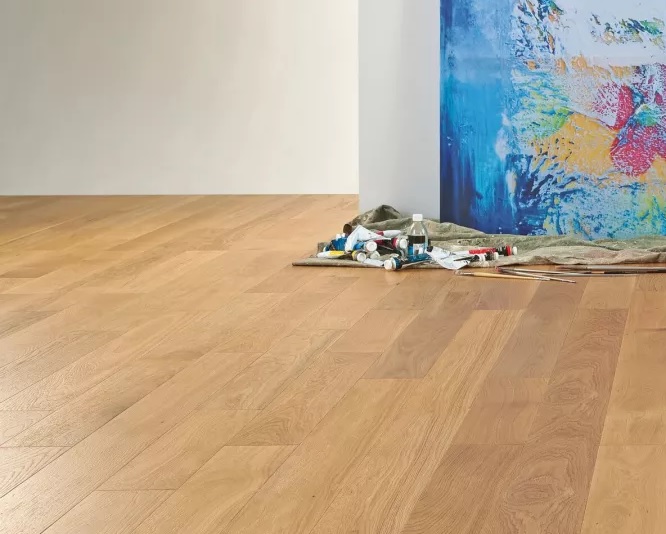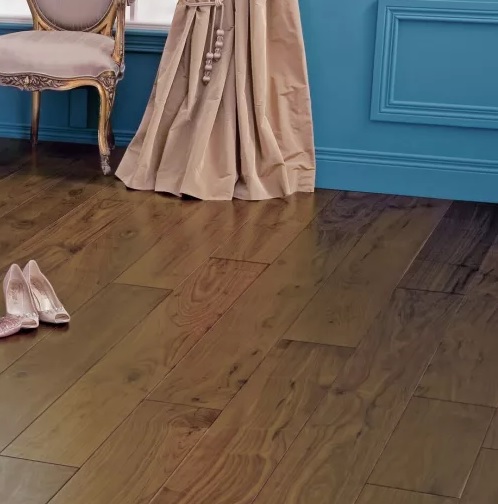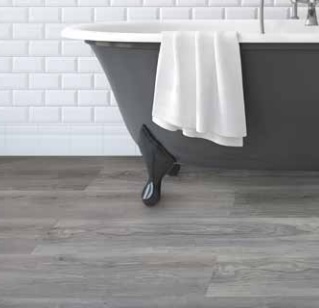Flooring Types Guide
Reading time: 6 minutes
Even simply browsing flooring types can be overwhelming. When you consider looks, durability and budget, there’s a lot to compare against. That’s why we’ve put together this guide to help you see what flooring is available, and what you need to know to make an informed decision.
Solid wood flooring 
Perhaps the most traditional type of flooring you can buy, solid wood flooring is also one of the most desired. This is likely down to the fact that it is tough, durable and an investment. Its appeal also lies in its appearance. A solid oak floor delivers a warm, pleasing veneer that suits rustic and modern properties. Each plank is made from a single piece of wood, offering an attractive and natural look to a floor, with each piece unique. Whether you choose light or dark solid wood flooring, the result is rewarding and characterful. As you might expect, solid wood does bring a higher price point with it.
If you’re thinking of laying solid wood flooring, it’s important to be aware of its limitations. Solid wood is tough and hardwearing, but it’s not good with extremes of heat, or exposure to water. Underfloor heating isn’t great for solid wood, and can cause it to bow. Spills and puddles must also be cleaned up quickly, even if the floor has been waxed and protected, as this can also lead to warping. A protective coat essentially buys you time, but doesn’t prevent water from soaking in fully. When cleaning, never use a wet mop, for exactly this reason. That said, there’s a satisfaction to owning a solid wood floor that adds a lot of charm to any home.
Benefits of solid wood flooring
Tough, durable, unique, characterful.
Where is solid wood flooring used?
Properties with good floor insulation, dry environments, homes without underfloor heating.
Engineered wood flooring 
Although this type of flooring doesn’t have solid wood running throughout each plank, it does retain a surface layer that’s made from actual wood. This means that the character and attractiveness of a natural wood surface is retained, but with some added benefits, including greater resistance to heat and moisture extremes. So if you’re considering a solid wood or engineered wood floor, engineered wood is better equipped for underfloor heating. Also, damp is less likely to cause engineered wood to warp (although any spills on a wood surface shouldn’t be left wet for too long).
This is thanks to the way engineered wood flooring is constructed. As we’ve already covered, the top (or decorative) layer is a thin ‘slice’ of natural wood which is bonded to the core. The core board brings the strength needed to support any weight placed on the floor, and is made up of different layers, which gives it the resistance to heat and moisture. There are different engineered flooring types, including:
-
HDF core flooring - Easy to fit, with simple click-fitting. Popular for DIY projects. These are thin, but strong boards, thanks to their High-Density Fibreboard (HDF) construction.
-
3-Ply engineered flooring - Durable and attractive, and best used in smaller spaces as it’s not quite as stable as multi-ply engineered wood floors, yet still offers an affordable, tough surface.
-
Multi-ply engineered wood flooring - Made from several core layers, multi-ply flooring is often the most common type of engineered flooring you’ll find, it’s able to closely mimic solid wood, offering long-lasting toughness for versatile use.
Benefits of engineered wood flooring
Durable, more resistant to heat and moisture than solid wood, and more affordable.
Where are engineered wood floors used?
Houses, apartments, offices, busy properties, places where heat extremities or liquid spillages are common (kitchens and bathrooms for example).
Laminate flooring 
The main reason why laminate flooring is chosen is for its affordability, but there are plenty of other reasons why it’s installed too. For flooring projects where budgets are tight, laminate offers a believable wood effect, while still being hard-wearing and durable. It’s made from layers of High-Density Fibreboard (HDF) as the main core, with decorative paper on the surface, which is then laminated. This creates an almost scratch-resistant coating, with varieties such as waterproof laminate flooring, which is ideal for kitchens or bathrooms. Because the panels are printed, this gives them a great deal of colour variety, tone and grain to suit any décor.
The other key benefit is their ease of fitting. They can be set in place, lifted and adjusted without permanent fixtures, such as nails or glue, which makes them perfect for DIYers. The only thing to watch out for is duplication when fitting. Because each surface is printed, there might only be a certain number of different patterns. Avoid placing two or three similar panels together as this can ruin the illusion of a natural wood floor.
Benefits of laminate flooring
Easy installation, scratch-resistant, durable, wide choice of finishes.
Where is laminate flooring used?
General residential properties, offices.
Vinyl flooring 
Vinyl flooring evokes thoughts of long rolls that are cut to fit a room, then glued down. Vinyl flooring roll is still available, but we’re no longer limited to this way of fitting vinyl flooring for bathrooms, kitchens and other rooms that benefit from this kind of waterproof cover. Tile vinyl flooring, or Luxury Vinyl Tiling (LVT) has made fitting easier and more manageable and is available in a broad choice of colours and patterns, replicating natural wood effects or coming in simple shades.
This goes a step further with composite flooring, which brings together the simplicity of fitting vinyl tiles, but with the added character of textured surfaces. Now it’s possible to order flooring that mimics stone or wood, lending extra authenticity to anywhere from a utility room to a wet room.
Benefits of vinyl flooring
Vinyl tiles are easy to fit, low cost, waterproof.
Where is vinyl flooring used?
Kitchens, bathrooms, wet rooms.
We hope this guide has provided clarity regarding your options and has helped you in choosing the perfect flooring for your project.
At Travis Perkins, we can offer the right flooring for residential and commercial properties, as well as underlay and adhesives, beadings and trims. Order online today.
Disclaimer: The information contained on this page is intended as an overall introduction and is not intended as specific advice from a qualified professional. Travis Perkins aims to avoid, but accepts no liability, in the case that any information stated is out of date.




